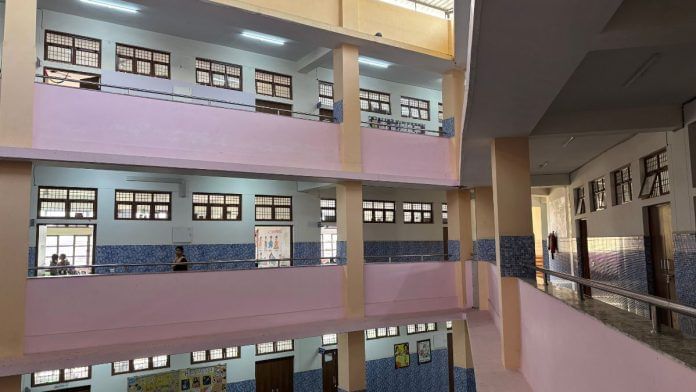Shamli/Baghpat/Greater Noida: Deep inside northwestern Uttar Pradesh’s Shamli, a red-brick Jawahar Navodaya Vidyalaya sits behind sugarcane fields and brick kilns in Bainswala village. The corridors are quiet after the afternoon bell, the lawns still, and on a smoggy day, students walk with masks pulled to their faces. As most children stream towards the mess in their blue track pants, one boy stays behind.
In a corner of the science lab, 17-year-old Vansh Saini leans over a circuit board, adjusting a thin wire with steady fingers. Three years ago, Vansh, the son of an auto-rickshaw driver left a private school to fight for a seat in this PM Shri residential school, hoping the move would give him a chance to build the future he dreams of.
“Teachers padhate they, samjhate nahi (Teachers used to teach, not explain),” he murmurs. What brought him here, and what keeps him hooked to the glowing boards and sensors in this room, is the promise that government schools can be more than low-cost options – they can be aspirational.
Vansh’s journey mirrors a larger shift playing out across Uttar Pradesh, now India’s biggest testing ground for the Centre’s Pradhan Mantri Schools for Rising India (PM Shri) scheme. The project, launched in 2022, aims to turn existing government schools, including Kendriya Vidyalayas and Jawahar Navodaya Vidyalayas, into NEP-aligned model institutions with smart classrooms, vocational labs, teacher training and upgraded infrastructure.
With 1,888 schools selected in UP, the state has become the scheme’s largest canvas. A Ministry of Education survey found that enrolment in 40 PM Shri schools rose by 75.8 per cent after receiving the designation, compared to their 2020-21 enrolment as state government schools.
In Shamli, that shift feels visible. But the ground reality across districts still swings between promise and patchwork – thriving labs in some schools, slow construction and old shortages in others.
“Not all government schools are the same,” said Dr Sunil Upadhyaya, founder and president of the All Progressive Teachers’ Association. “Schools like Kendriya Vidyalayas and Jawahar Navodaya Vidyalayas have stronger infrastructure and better trained teachers because they are centrally run.”
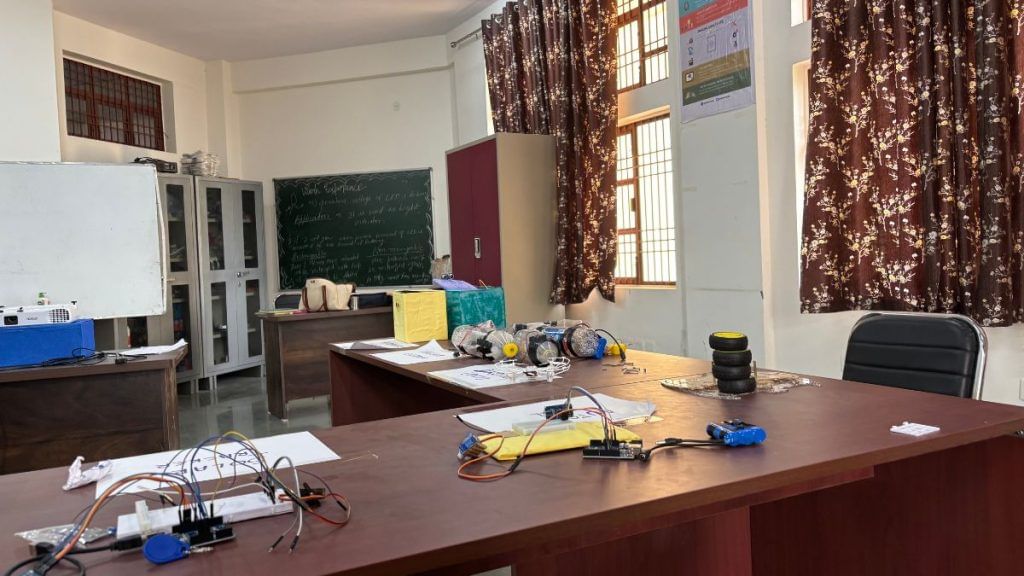
A journey from private to govt school
In Vansh’s village, many children drop out after Class 8, heading to factories and workshops in industrial belts like Karnal, Panipat and Kurukshetra in Haryana. Vansh wanted a different route. He wanted a shot at JEE, a better job, and a school where learning didn’t feel like memorising from worn-out notebooks. The Navodaya seat in Shamli became that opportunity.
The science lab he works out of serves as that symbol of hope for Vansh. A smart board glows against a brick wall; microscopes, 3D printers and tools sit on shelves.
“This lab remains open for us,” he says. “What we learn here, we can make as well.”
Across the hall, Class X student Ajit Kumar Chauhan works quietly beside a physics demonstration setup. He too left a private school after Class 5 because he felt the school wasn’t beneficial for competitive exams.
“The school I was in didn’t have experienced teachers. Most of the teachers were from the village itself. One teacher, three subjects,” he says. “But here, each subject has a specific teacher, and all the teachers have passed an all India exam. They are more qualified and experienced.”
School principal Yogesh Kumar walks through the corridor, stopping briefly at a freshly painted door marked Atal Tinkering Lab. Inside, unopened kits and a boxed printer cover a table.
Also Read: ‘Milestone’ pact after 3 years of resistance—the debate over PM-SHRI & what’s behind Kerala’s U-turn
“These are the kind of tools these children once only saw in glossy brochures of private schools,” Kumar says. “Earlier, parents used to send their kids to private schools because they thought the teaching was better, now, it’s the other way around. They’re trying to get admitted into government schools.”
Dropout numbers, he says, have fallen.
“Our target is 100 per cent admission, 100 per cent results, and 100 per cent first division. Private schools are all about marketing, but quality and discipline is here,” he adds.
Over an hour away in nearby Baghpat, however, the view is more tempered. At Arpan Public School, principal Mandeep Saini says the government’s efforts are encouraging but incomplete.
“For junior classes, private schools are a preference for parents, they have seen results,” she says. “Private schools are the testing ground for most students.”

Then vs now
In Chhittera, Dadri, the transformation feels even more recent. The government composite school stands in a dusty village lane, and inside, the Learning by Doing Lab doubles as the principal’s office. Principal Rajni Sharma sits at a table, flanked by two fans that ventilate the room.
“When I came to the school in 2015, there was no proper roof,” she says. At the time, the annual budget was Rs 6,500. After becoming a PM Shri school in 2023, the amount rose to Rs 1 lakh, and with it came new spaces: a Baal Vatika for preschoolers, an LBD lab, a digital library, solar panels and computers in the ICT lab.
“Even though the building has changed, and there are more amenities, more students are coming to school,” she says.
Most parents here are daily wage workers. Teachers often call, visit homes or offer small prizes to encourage attendance. Outside the gate, Sohail Khan, a driver, waits for his daughter Sadiya, who studies in Class VI.
“Now, Sadiya has access to a computer, while I couldn’t afford one,” he says. “The teachers have been supportive and even allow students to stay late for extra classes, if needed…”
But he also worries that change should not be superficial.
“It’s good to see these changes in curriculum, but it should last. Teachers should be supportive… we don’t have the money to afford coaching or tuition classes,” he adds.
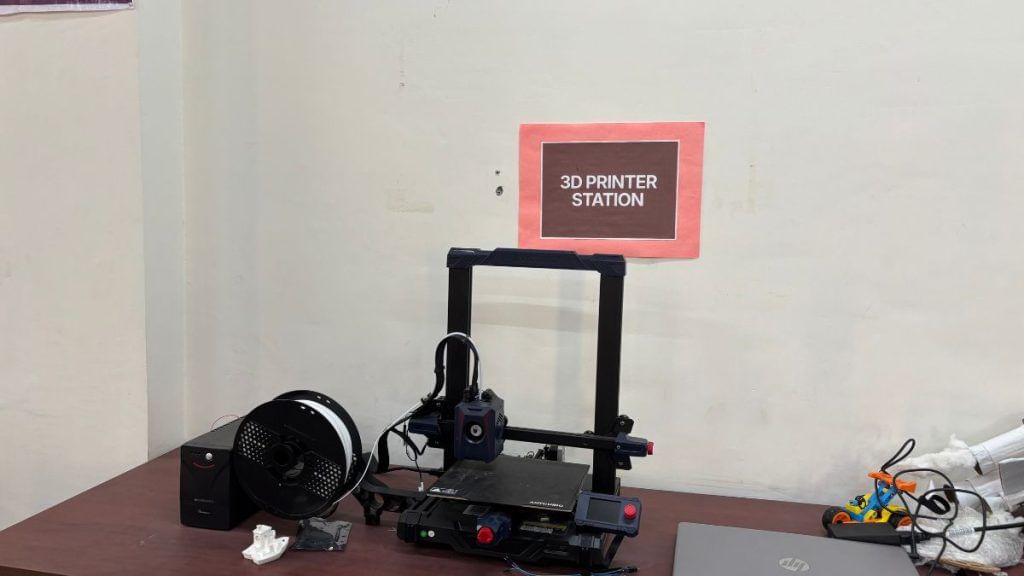
A push for better infrastructure
Farther away, the PM Shri Kendriya Vidyalaya in Baoli looks like the showpiece of the scheme. A life-size cut-out of Prime Minister Narendra Modi stands at the entrance; the gates and walls are painted with the tricolour logo.
“When you walk into a PM Shri school, you should feel the difference,” principal Nawal Singh says. “The aesthetics, the discipline, the learning environment, everything should reflect the new standards of public education.”
Inside, classrooms have interactive smart panels. Students tap, swipe and solve problems that once would have been chalked on a blackboard.
“Now, our students see and hear concepts in real time. The visuals hold their attention,” Singh says.
The Atal Tinkering Lab inside the school includes stations for electronics, robotics, 3D printing and toolwork. A vocational lab now offers courses in AI and handicrafts.
Also Read: All about CM Shri schools, Delhi govt’s bid to reform public education
“These aren’t new buildings,” says Baghpat District Magistrate Aparna Lal, who oversees PM Shri monitoring visits. “They are old schools that have been given a second life with modern classrooms, labs and digital tools that complement traditional learning. It’s about nurturing skills and confidence.”
Lal says officials visit 10-20 schools every month – announced or unannounced – checking midday meals, kitchens, attendance and teaching practices. Teachers now mark digital attendance with GPS-tagged photos; inspection reports are filed on an online portal.
“We’ve come a long way from what people imagined government schools to be,” she says.
Yet even here, the pace is uneven. According to the Parliamentary Standing Committee on Education, fund utilisation under PM Shri remains “very poor” and while “the vision is strong,” the committee notes, “execution must match ambition.”
Still, the DM sees something shifting.
“Earlier, government schools were seen as a last option. This infrastructure made dreams visible,” Lal said.
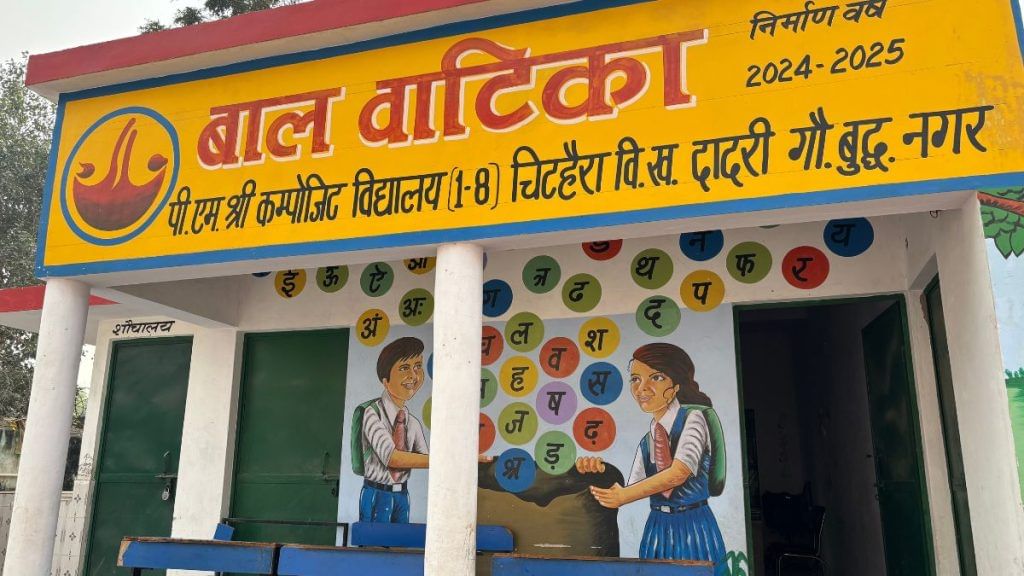
Schools still waiting
In Dhoom Manikpur, Greater Noida, the contrast is immediate. A composite government school sits beside the old NH-91 highway, dusty and cramped. Students play on kaccha ground outside the principal’s small office.
The school, built in 1974, has over 300 students and 14 teachers. Principal Sushma Rani says proper infrastructure, like a tiled-playground, are missing because the school is not under the PM Shri scheme.
“We also wanted a lab like Learning By Doing,” Rani adds. “It would benefit our students to learn practical skills, and think about jobs beyond their village.”
The school receives just Rs 50,000 a year for maintenance. When things break, teachers spend from their own pockets. Much of the furniture and paint has come from NGOs and corporate grants. The school applied twice for PM Shri status; both times it was denied.
“If we had those facilities: smart classes, proper labs, clean grounds, things would have been different,” Rani says. “The children here deserve that chance too.”
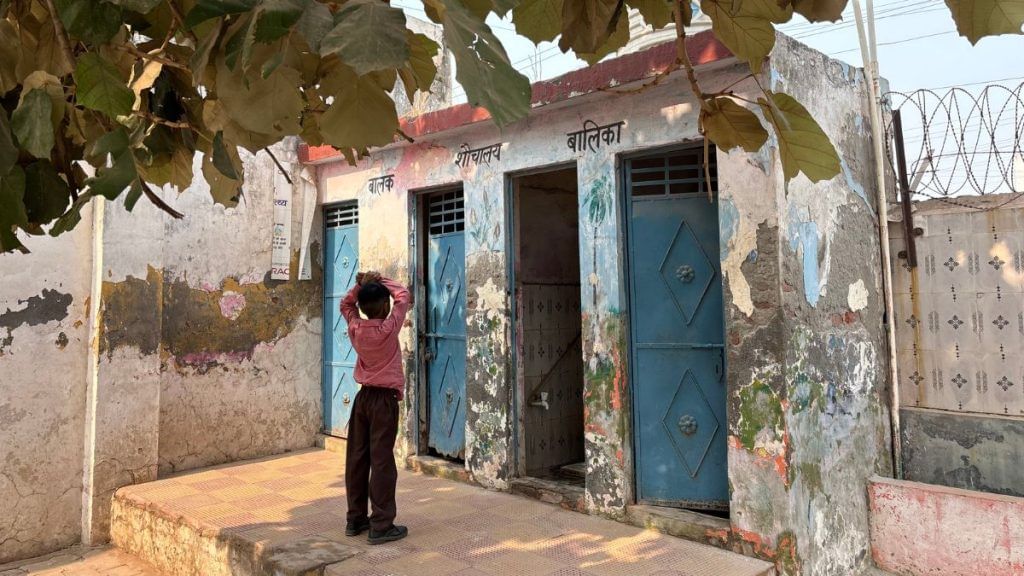
Carrying the teaching forward
For teachers who studied in old government schools, the change is personal. In the Learning By Doing lab in Shamli, Ashish Kumar, 25, remembers learning multiplication tables on a slate, writing on paper only in Class VI, and never touching a machine.
Now, he teaches students to build small machines out of scrap. “Kabad se jugaad banana,” as he puts it, along with plumbing, electrical basics, health and agriculture modules.
“Earlier, government schools didn’t have spaces where children could touch, fix, and learn,” he says. “Now, even Class VIII kids handle tools confidently. They want to come to school.”
In Greater Noida, Manisha Kumari, 27, teaches Classes I and II. She too studied in a government school.
“When I was a student, we just memorised poems,” she says, as she stands between a laptop and a digital screen. “Now, I use a projector to show the same poem through images and music. Children respond instantly.”
Her day begins with a WhatsApp schedule detailing activities period-wise. Her classroom revolves around NCERT workbooks, poems and songs.
“Earlier, parents used to send their kids for mid-day meals,” she says. “Now, they see their children learning English poems, using smart boards.”
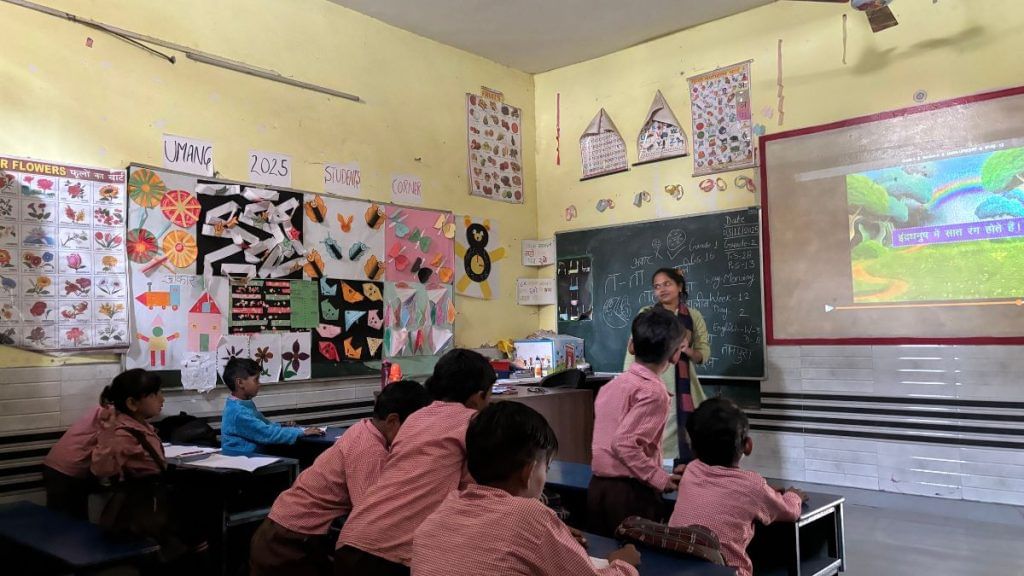
The next generation
In Dadri, 13-year-old Saniya Mirza runs across the school field, telling her friends about her first school trip. Under the PM Shri scheme, excursions have become compulsory, and last month she visited a Canara Bank branch in her district. Bank employees showed the children how to fill forms, sign their names, and use a fingerprint scanner.
When she told her father, who works at wedding functions, he was delighted.
“I told him I signed with my name on a sheet of paper,” she says. “He told me he only thumb-printed his signature all his life. This is what my school taught me.”
(Edited by Stela Dey)



